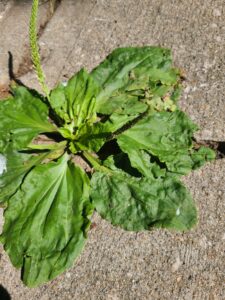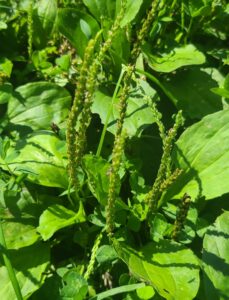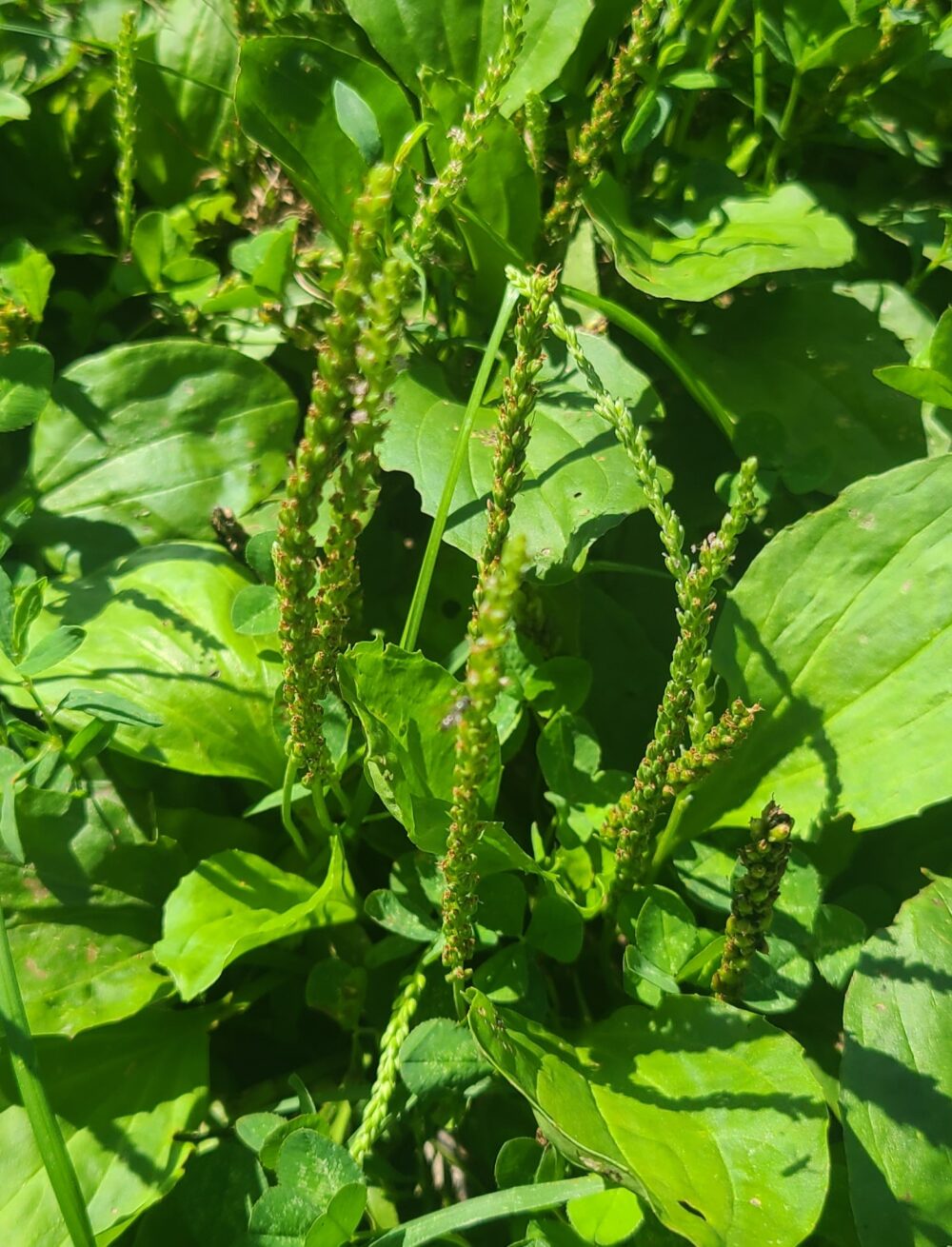Ode to the Pervasive Plantain
Plantain, plantain
So much we can gain
Healing wounds, killing germs
Growing sweetly in the lane.
This is my “Ode to the Pervasive Plantain”. There’s so much to say about plantain and one of the best things about it is that it grows almost everywhere. I was walking home from the grocery store today feeling sorry for myself because, inexplicably, my right eye lid is swollen. As I was walking, I was pondering what to do about this quandary when I looked down and saw a beautiful patch of plantain. “Oh!”, I exclaimed, “the perfect remedy”! I bent down and grabbed a few leaves to take home to make a poultice. As I was continuing my journey home, I realized that I should have gotten a photo for this blog post. Then I realized that there would be endless opportunities to get some good photos because plantain grows EVERYWHERE!

Now, don’t confuse the herb plantain with those funny little banana-like fruits at the grocery store. Yes, those are also called plantain, but I’m writing about the herb Plantago rugelii. Most people probably think this little plant is just another “weed”, but let me tell you, my friends, plantain is the best!
Plantain is part of the Plantaginaceae family which also contains foxgloves and snapdragons although, I don’t believe either of those are typically used medicinally. There are a few members of this family that are used medicinally, Plantago major, rugelii, and lanceolata. In my area (Kansas City) I usually find the rugelii species.
Ok, enough science-y stuff. Let’s get “real life” here. One of my favorite aspects of plantain is its vulnerary abilities, meaning it’s a wound-healer. Plantain works with all your skin tissues including the skin that lines your digestive tract. So not only will plantain heal your stubbed toe, but it will also heal your leaky gut syndrome! Been taking NSAIDS or other pharmaceuticals that wreak havoc on your digestive system? No worries! Have some plantain tea and it will heal right up. Ok, you might have to drink some every day for a bit, but better to heal it than just let it get worse. Maybe don’t drink plantain tea on its own, though. I don’t find it particularly tasty. You can just put some in with other herbs and it will still work. Calendula is a great addition along with peppermint or ginger, chamomile, and yarrow. By the way, this herbal tea will also make a great compress for that cut on your arm.
With its drawing ability (like sucking out something not creating art), plantain is super helpful for stings, bites, rashes, and even splinters. A poultice or compress of plantain will help draw out the toxins from a poison ivy rash and then help heal the skin and relieve the itchiness.
Plantain is anti-inflammatory, antimicrobial, antispasmodic, astringent, demulcent, diuretic, expectorant, styptic, and vulnerary. AKA, a great herb to have around and, thanks to Mother Nature, you can probably find some in your own backyard. Or here in my online shop it that’s easier for you. 😊
Best ways to work with plantain
You can work with plantain as a tea, tincture, or salve, but you can also just work with the fresh leaves. If you pick some leaves from a safe place (i.e., where it hasn’t been sprayed with weed killer or other chemicals) you can mash them up and put them right on the wound as a poultice. You can also use fresh leaves in tea to drink or to use as a compress. If you prefer to work with dried plantain, you can purchase it in my online herb shop.
If you are using a compress, poultice, or salve for wound care, you can apply it 3-5 times per day. If you are drinking plantain tea to help heal your digestive system, 3-4 cups a day or a quart of tea a day is a good amount. You can’t really overdose on plantain, but make sure to pay attention to how your body is feeling. It is a diuretic, so if you are getting dried out, try adding something like marshmallow root or leaves to your tea.
Precautions
If you are harvesting your own plantain, please make sure you know what you are picking. Many plants can look similar to each other but have very different effects on the body. I like to use an app such as Picture This to help me correctly identify plants out in the wild (aka, outside my yard) (or even sometimes in my yard).
Use of the plantain leaves is generally regarded as safe. As with all herbal medicine and pharmaceutical medicine, always pay attention to how your body is feeling. Although, I suppose you should just always pay attention to how your body is feeling! It’s a good habit to get in.

So go out and pick some plantain. The fresh air will do you good too!
A little disclaimer…
The information here is not meant to diagnose, cure, treat, or prevent any illness. Please see a qualified herbalist or doctor before beginning to work with herbs for any serious health conditions and read and pay attention to any precautions listed for each herb. Herbs are powerful medicine and should not be taken for granted.
You are completely in charge of your own health. The information here is meant for educational purposes only. It’s up to you what you do with this information. Please remember that no doctor can tell you what to do and how you should care for your body. It is your right and your responsibility to make the decisions regarding your own body. Finding your own path to wellness (whatever that means for you) is a journey. The information here is only to give you options on how to care for your body on that journey.
